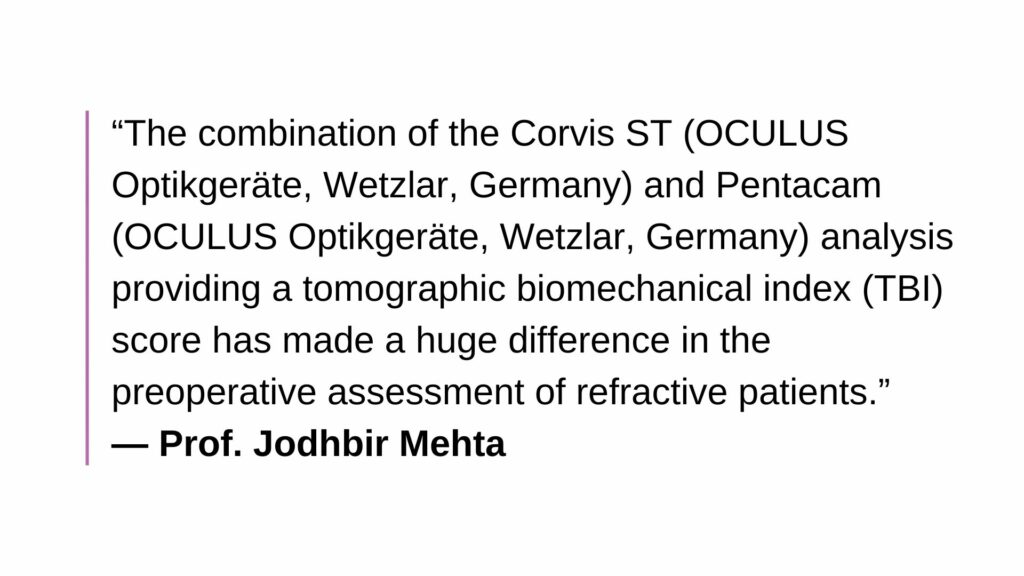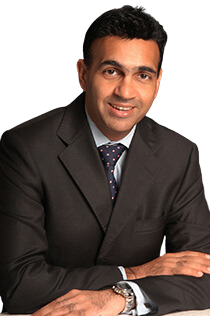Anterior segment is a thriving hub for progress and innovation, all dedicated to achieving better patient outcomes. Imaging advancements have enabled us detailed and comprehensive visualization of all the anatomic complexities of the eye, leading to more accurate diagnoses and effective treatments. The introduction of innovative IOLs demonstrates a paradigm shift in presbyopia compensation. Furthermore, the significant impact of AI in the anterior segment is expanding, with AI applications integrating with imaging modalities for enhanced detection and diagnosis of various eye conditions.
The evolution of treatment and refractive precision is highly impactful for patients. And as we know, patients nowadays do not hesitate to share their high expectations – and even more so when not met.
The current available technology and treatments, as well as those in development, allow us to deliver the most effective solutions and achieve the most refined visual outcomes like never before.
The ever-evolving IOLs
Dr. Florian T. A. Kretz, the founder, owner, and lead surgeon at Precise Vision Augenärzte in Rheine, Germany, has witnessed firsthand the rapid evolution of anterior segment medicine.
“Cataract and refractive surgery has always been a sub-specialty with numerous innovations and paradigm shifts in recent years. Besides the development of new intraocular lens (IOL) designs several times a year, IOL calculation and diagnostics are continuously evolving,” shared Dr. Kretz.
Despite ongoing refinements to IOL design, undesirable dysphotopsias remain one of the most common complaints following cataract surgery. The latest developments in IOL design aim to address such issues, including unwanted bursts of light and halos in the central or mid-periphery of the visual field. These innovations involve shifting the optical power more anteriorly than posteriorly, rounding the anterior portion of the square edge, reducing the thickness of the square edge and leaving the edge unpolished.
Recent additions to the range of Johnson & Johnson’s extendeddepth- of-focus (EDoF) IOLs includes the Tecnis Symfony OptiBlue and Tecnis Synergy, which have InteliLight technology. InteliLight’s latest advancements boast a violetlight filter that reduces halo, glare, and starburst effects. Additionally, the echelette design minimizes light scatter and halo intensity, while achromatic technology corrects chromatic aberration, allowing for better contrast in both bright and dark lighting conditions.
Sometimes, innovation can take the form of revisiting something familiar and exploring how it can be enhanced with the technology available today. While the focus has been on developing premium IOLs, with all the bells and whistles, looking back to the good old reliable monofocal — with its almost perfect uncorrected distance vision and minimal photic phenomena — may be worth another look.
“More of a trend or paradigm shift than innovation are the so-called monofocal plus IOLs. Just a decade ago, everyone was focusing on the compensation of corneal spherical aberration to increase contrast and achieve a sharper image, especially under scotopic pupil sizes. Now we find ourselves going back where we came from by using inverted spherical IOLs with a higher dioptric power in the center to increase the range of focus for additional presbyopia compensation,” Dr. Kretz explained.

The updated design is based on a continuous refractive optical surface that results in a progressive increase in power from the periphery to the center of the lens, delivering true intermediate vision.
The latest in imaging and diagnostic technology
Prof. Jodhbir Mehta is the executive director of the Singapore Eye Research Institute (SERI) and a distinguished professor in the Corneal & External Eye Disease and Refractive Department at the Singapore National Eye Centre (SNEC). He shared that among various advancements, imaging and diagnostic innovations have had the most significant impact on his clinical practice.
“The combination of the Corvis ST (OCULUS Optikgeräte, Wetzlar, Germany) and Pentacam (OCULUS Optikgeräte, Wetzlar, Germany) analysis providing a tomographic biomechanical index (TBI) score has made a huge difference in the preoperative assessment of refractive patients,” Prof. Mehta said. “The Pentacam provides tomographic data integrated with biomechanical data from the Corvis ST to improve sensitivity and specificity in the detection of patients who could possibly develop ectasia after refractive surgery,” he added. “This technology has also been extremely valuable in the assessment of patients with presumed unilateral keratoconus.”
Dr. Kretz also acknowledges the impact of advancing technology in diagnostics. “The biggest trend over the last five years is the implementation of optical coherence tomography (OCT) technology in anterior segment diagnostics,” he said.
To demonstrate the progress of anterior segment OCT (ASOCT), early devices had a penetration depth of 7 mm and captured between 200 and 2000 scans per second. In comparison, current Fourier-domain OCT devices designed for anterior segment imaging offer scan depths of 2 to 3 mm and scan speeds ranging from 26K to 110K scans per second.
This large volume data capture allows for a 360-degree assessment of the anterior chamber angle and quantifiable parameters, such as iris volume and anterior chamber volume. Intraoperative ASOCT has also been integrated into femtosecond laser platforms and operating microscopes. This technology allows for real-time intraoperative guidance during cataract surgery, visualization of wound morphology, lens hydrodissection, trenching depth during phacoemulsification, and IOL positioning.
Today, OCT devices can also incorporate epithelial thickness mapping technology. Dr. Kretz explained its added value: “Epithelial mapping is helping us to understand remission after refractive laser surgery and to detect corneal diseases like keratoconus quicker than with front surface topography. But in biometry, this technology also offers even better outcomes in corneal astigmatism treatment.”
By mapping the epithelium and quantifying epithelial thickness, we can achieve accurate measurements of the stromal surface, leading to a revolutionary approach to managing astigmatism.
Real game-changers in the anterior segment
We asked our experts about the latest anterior segment innovations currently in development that they believe will be true game-changers in clinical practice.
“There are several innovations on the way that we are all eagerly looking forward to. Probably one of the biggest is the possibility to treat hyperopia with lenticule extraction in the near future,” Dr. Kretz shared.
This was an intriguing technique, originally proposed over a decade ago. However, the technology available at the time was not sufficient for the task. Since then, innovations to the small incision lenticule extraction (SMILE) technique, including an improved nomogram, modifications to the lenticule geometry, an increased transition zone of 2.0 mm, and optimization of the energy settings on the VisuMax (Carl Zeiss Meditec, Jena, Germany) femtosecond laser have successfully resolved earlier challenges.

The SMILE for hyperopia trial had remarkable results. They reported that 83% achieved corrected distance vision of 20/20 or better after 12 months. And for those with a plano target, at 12 months, 68.8% had an uncorrected distance visual acuity of 20/20 or better, and 88% had at least 20/25. 1
Prof. Mehta has been watching the ongoing trials of drug-eluting IOLs. “This could be an interesting technology with the potential to have far-reaching applications, especially for the patients we treat with chronic diseases, such as glaucoma, who are undergoing cataract surgery,” he shared.
SpyGlass Pharma (California, USA) is evaluating their single-piece, hydrophobic acrylic IOL with drugeluting pads, which in early studies demonstrated significant intraocular pressure lowering in patients with glaucoma or ocular hypertension. The ultimate goal would be to enable cataract surgeons to use existing IOL techniques to improve the patient’s vision due to cataracts and deliver multiple years of bimatoprost therapy for those who also have glaucoma. This may also be the solution to the ongoing challenges associated with adherence to daily drop regimens, a significant issue in treating glaucoma and other ophthalmic diseases.
Other drug-eluting IOL investigations have included hydrophilic modification of the IOL surface using heparinization or pegylation as a method to decrease initial cellular adhesion and inhibit posterior capsule opacification.
Companies like VisusNano (London, United Kingdom) are also developing biodegradable polymer-based drug elution systems that can be attached to the IOL. These systems allow controlled and slow release of antibiotic, anti-inflammatory and anti-proliferative agents to prevent cell proliferation — thereby reducing infection and inflammation risk and avoiding the need for eye drops or postoperative laser treatment.
Regenerative medicine using cell-based therapies is also a hot topic in corneal disease innovation as a way to replace or enhance damaged tissue. The challenge with these types of therapies is that for delivered cells to integrate with the host tissue, they need to stay at the site of delivery. The team at Emmecell (California, USA) has developed a magnetic cell delivery nanoparticle platform, effectively localizing and integrating cell therapies to the appropriate target tissue. The evaluation of this technology in eyes with corneal edema is currently in clinical trials in the United States.
AI to the rescue
When it comes to innovations in the anterior segment, discussions would not be complete without acknowledging the significant impact of artificial intelligence (AI) technology in clinical practice.
The potential value of AI in anterior segment ophthalmology is expanding, particularly for the areas that involve big data and image-based analysis. With growing populations and limited ophthalmic care in remote communities, there is a growing value in AI-based telehealth applications.
AI applications have integrated with imaging modalities, complementing the detection of keratoconus, preoperative screening for risk of post-refractive surgery ectasia, diagnosis of infectious keratitis, and prediction of post-corneal graft complications. 2 AI algorithms have been used to help clinicians detect and differentiate clinical diagnoses with high sensitivity, specificity, and accuracy. As an example, a trained artificial neural network accurately classified bacterial and fungal keratitis with a rate of 90.7% compared with the clinician’s prediction rate of 62.8%. 3
Once adequately trained, AI excels in image analysis. Remarkable examples include AI conducting semiautomatic analysis of corneal ulcers from photographs and providing reliable automated detection of Descemet membrane endothelial keratoplasty graft dislocation.
Furthermore, AI has been applied to predict treatment outcomes for eyes with keratoconus. It has also been used to screen refractive patients at high risk of developing progressive post-LASIK ectasia and visual disability after any laser vision correction with >90% accuracy.2 With that said, the deployment of AI into everyday clinical practice still has several hurdles to clear. Many of the reported achievements are based on algorithms trained using limited samples, with relatively few being validated in real-world scenarios.
Innovation is driven by the desire to deliver safe and effective sight-saving opportunities, ultimately improving the lives of clinicians and patients alike. Dr. Kretz emphasizes the importance of staying updated on cutting-edge advancements to deliver the best possible care to patients. Moreover, he is supportive of the latest innovations, always keeping an eye on the future of eye care.
“As anterior segment surgeons, we are very happy that there is continuous innovation in our field. And I look forward to seeing what comes out next,” Dr. Kretz concluded.
Editor’s Note: A version of this article was first published in CAKE Magazine Issue 19.
References
- Reinstein DZ, Sekundo W, Archer TJ, et al. SMILE for Hyperopia With and Without Astigmatism: Results of a Prospective Multicenter 12-Month Study. J Refract Surg. 2022;38(12):760-769.
- Ting DSJ, Foo VH, Yang LWY, et al. Artificial intelligence for anterior segment diseases: Emerging applications in ophthalmology. Br J Ophthalmol. 2021;105(2):158-168.
- Saini JS, Jain AK, Kumar S, et al. Neural network approach to classify infective keratitis. Curr Eye Res. 2003;27:111-116.





